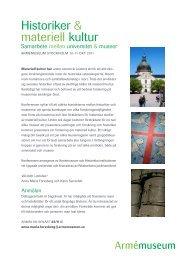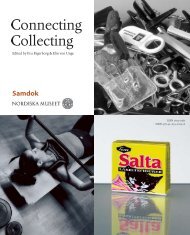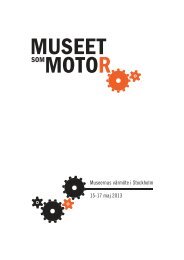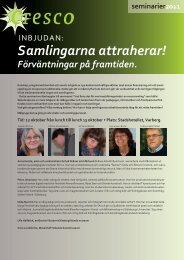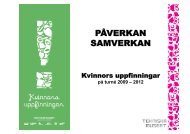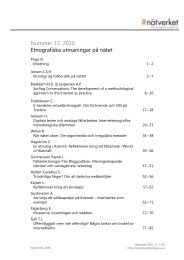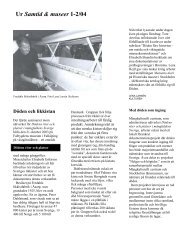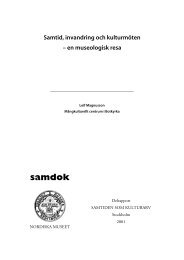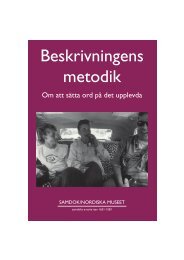Connecting Collecting - Sveriges Museer
Connecting Collecting - Sveriges Museer
Connecting Collecting - Sveriges Museer
Create successful ePaper yourself
Turn your PDF publications into a flip-book with our unique Google optimized e-Paper software.
The Pool for Management of Natural ResourcesGallejaur. Photo Daryoush Tahmasebi© NorrbottenMuseum.During 2004–2005 Västergötland Museum,in collaboration with VästraGötaland Regional Museum, conducteda survey of silos, the tall storage towersfor grain that set their mark on the landscapein many places. Some silos wereinvestigated in detail, a history of thedevelopment of silos was compiled, anda survey of the current situation.This study was done in the nick oftime. In the very last minutes of 2005the agricultural organization Lantmännenproduced its own survey, OperationBlue Light, of the silos in its ownership.It shows that only a few of these “surplusbuildings” will be used in the future.Most of them will be demolished, butsome can perhaps be preserved as monumentsto a change in operations.The study of silos in western Swedenhas spawned successors in other parts ofthe country. Soon we may have a morecomprehensive survey of what Swedenlooked like before the great silo closurewas completed. What is interestingabout the silo study in western Swedenis that it put the focus on a type of buildingand agricultural activity in radicalchange. The study also created a foundationfor the decisions that have to betaken concerning these buildings in thenot too distant future.Meanings of nature for residentsand visitorsSurrounded by the Vindelfjällen naturereserve is the little community of Ammarnäs,which has gained attention forthe struggle over natural resources thathas been waged by different actors, bothlocal and non-local. Tourism has stoodagainst reindeer herding, conflicts haveraged over the rights to hunting andfishing, and relations between differentgroups have been fraught. Now solutionsare being found to the conflicts overnatural resources through local administrationand coordination in “the AmmarnäsCouncil”.To study today’s living conditions inthis village and views as to how land –the common resource – should be used,the Pool for Management of Natural Resourcesinvited other Samdok pools to afield seminar in August 2007. What arethe strategies for the village to survive,how do they see the future, what doesit mean to live in a nature reserve? Thefield seminar was organized by VästerbottenMuseum, which thereby acquireda larger circle of colleagues as partners indialogue, while simultaneously obtainingnew material.Museum farmsThe museum farms that can be foundat several museums in Sweden are alsointeresting for the work of the pool.How do the museums preserve the oldknowledge associated with the farms,and how can this be used in the presentand the future? The question of a sustainablesociety is highly relevant for allthose working with old farming techniques.The museum farms can be a bankof knowledge which could be useful ina new way in the work with tomorrow’ssociety.Cultural heritage in changeOther studies in recent years have dealtwith different aspects of agriculture.Uppland Museum, which has agricultureas one of its profile areas, hasdocumented a hypermodern byre withrobot milking facilities and is doing researchon how ideas about landscape,people, and countryside are expressedin political language, and about changesof generation and property transfers onfarms in Sweden, Estonia, and Hungary.The County Museum of Gotland iscurrently working on a project abouttourism, where farmhouse accommodationand alternative uses of outbuildingshave become new sources of income forfarmers. Another project concerns theextraction and production of lime, withthe focus on how this affects nature andthe environment.Interviews and photographic documentationfrom earlier Samdok studieshave also been used in research onagrarian history, as part of the sourcematerial for Jordbruket i välfärdssamhället1945–2000 (“Agriculture in the WelfareState”), volume 5 in a series on thehistory of Swedish agriculture (Flygare &Isacson 2003).The studies and other experiencesfrom local museum work are ventilatedcontinuously in the pool. We arrangelectures, study visits, and seminars, andthe pool serves as a resource for supplementaryeducation and networking forthe participating museums. We deal withcurrent issues and try to keep up withthe latest research. The pool for Managementof Natural Resources documentsa cultural heritage that is changing radically,and this work is very important forthe future. pAnn-Katrin Wahss is department head atVästergötland Museum and chair of the Poolfor Management of Natural Resources,ankie.wahss@vgregion.se.Eva Gradin is head antiquarian at NorrbottenMuseum, eva.gradin@nll.se.Samtid & museer no 2/07 • 15



